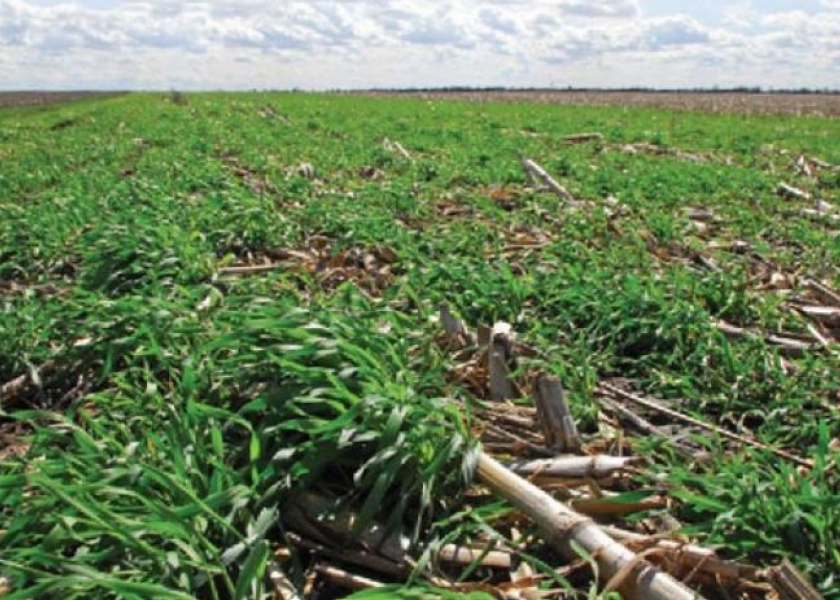The Perfect Storm: Now’s the Time to Safeguard Your Soil

A dust storm rippled through the Midwest late last week, followed by rain in some parts and continued heat in others. The Great Plains is no stranger to this weather phenomenon, but producers up north are less familiar with it.
Images of the storm look eerily familiar to a notorious event that took place nearly a century ago—the Dust Bowl. However, meteorologists are categorizing the system as a derecho.
Pretty crazy storm front.... We were lucky compared to others... No damage SW Mn, @snodgrss @NWSSiouxFalls pic.twitter.com/BJM2xfEM99 — Matt Grussing (@GrussingMatt) May 13, 2022
The weather system that started in Nebraska made its way through Iowa and South Dakota, leaving behind extreme damage in some regions, with less in others.
A First for the Corn Belt
In Northeast Iowa, the storm plowed-in at 80 mph for roughly 15-minutes. Couple an abnormally dry spring with record-breaking winds at the start of planting season and you have a recipe for “the perfect storm," according Rosie Roberts, Iowa Soybean Association conservation agronomist.
However, she says the wild weather event didn’t bog-down producers’ moral.
“Folks are eager to get out in the field and keep planting as much as they can,” she says. “The only bright side of the storm is we didn’t have a whole lot of rain to put people out of business for the week. Just this morning I saw a few people in the field, completing seedbed prep tillage.”
Following the dust and wind, Roberts says an inch of rain made its way to the soil—something her area desperately needed. She says this La Nina weather pattern kept her territory’s soil temperatures around 50-degrees until last week, while the drought monitor categorized her region’s moisture severity at 1 out of 10.
Lights Out in South Dakota
Nate Hanson from Dell Rapids, South Dakota, says there wasn’t any warning for the storm. Ten minutes after seeing the wall of dust from afar, the storm was at his doorstep.
“Two of our buildings are a complete loss with two others that have heavy damage, and we have probably 20 trees down,” he says. “I’m 44-years-old and I’ve never seen anything like it.”
Preventing Another Dust Bowl
This weather event highlights how safeguarding soil through cover crops should be a high-level priority in preventing wind and water erosion, according to Roberts.
"Given the erosive activities that we’ve had over the last month or two, this will definitely get people talking," she says.
Cereal rye is the cover crop of choice in Roberts’ region. She says the biomass is what keeps it top of the charts.
“After the cereal rye is seeded, you'll get a little bit of growth before the first frost comes and then it's a winter hardy plant so it over winters. Once we start getting warmer spring temperatures, it starts to green up and actively grow, which helps keep a cover on the soil while nutrient cycling goes on the underside of the soil,” Roberts says.
Sioux county—Roberts’ territory—leads the state of Iowa in livestock production. Cereal rye has been a popular choice in the areas as it opens the door for livestock grazing. And, Roberts says a handful of her customers who don’t have livestock opt to terminate the crop or proceed with no-till planting beans into the cover crop biomass.
Silage fields also provide an opportunity.
“Chopped silage fields are great opportunities to seed cover crops in because you can get in early enough ahead of any frost date, and then you can harvest the biomass for the livestock. It helps keep your soil in place and safeguarded against erosion,” she says.
Roberts says having technical assistance in boots-on-the-ground is “vital” in making cover crops show up in your ROI. She suggests contacting a conservation agronomist or industry expert to get started.
“The assistance is out there,” she says. “You just have to look for it.”
More on cover crops:
> Cover Crop Decisions: Thorough Planning Increases The Odds For Success
> Do Cover Crops Pay? Evaluate Your ROI in These Two Ways
> USDA Unveils Pandemic Cover Crop Program for 2022







